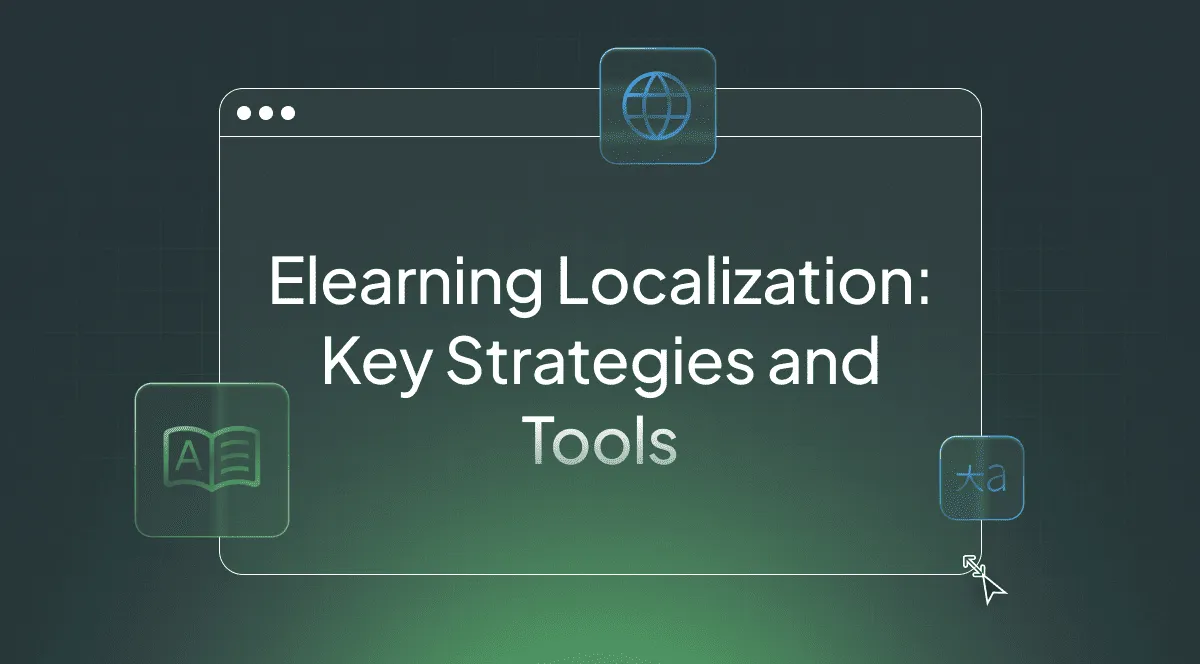To deliver effective training content to a global workforce or launch educational projects in new markets, organizations must overcome language barriers. eLearning localization is essential for making knowledge accessible to an international audience.
In this article, you will learn:
- What is eLearning localization, and how does it differ from translation
- What are the key benefits of eLearning localization
- Why it’s important to adapt content to cultural differences
- eLearning localization challenges and ways to solve them
- Why Crowdin is the best solution when translating eLearning content
- What are the future trends in eLearning localization
- Steps to go global with multilingual courses
What is eLearning Localization?
eLearning localization is the process of adapting any type of digital learning material (such as an online course, a training video, or a quiz) from its original language into a target language, while also considering the cultural context. The main goal is to make the learning experience just as good for a learner in Japan as it is for one in the U.S.
Understanding eLearning localization vs. translation
You’ll hear these two terms a lot, and they’re closely related, but there’s a key difference.
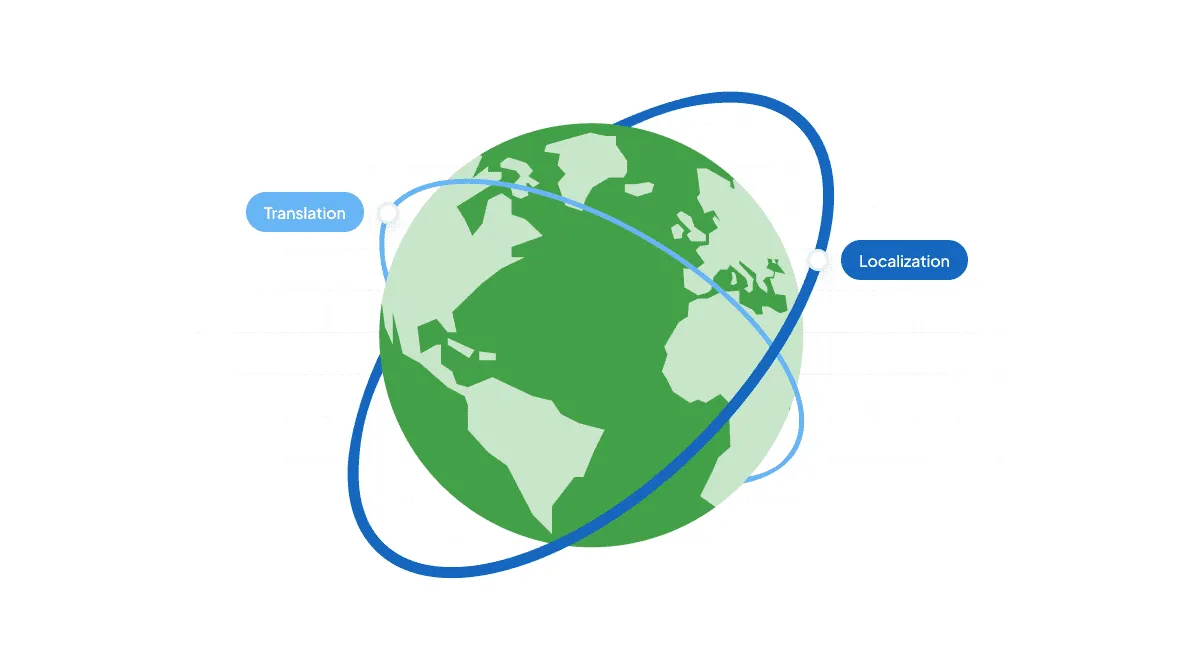
- Translation is the direct linguistic part. It’s simply converting the words from one language to another. Think of it as the basic word-for-word conversion.
- Localization is the full package. It includes translation but also adapts the entire course to fit the cultural context of the new audience. This means changing everything from currency symbols and dates to the images, examples, and even the tone of the content. Localization leads to a better understanding for learners.
Types of eLearning Content Requiring Localization
Pretty much anything you use for online learning can and should be localized. This includes:
- Online courses themselves, from simple modules to complex simulations.
- Video and audio, whether you add subtitles or a full voiceover.
- Interactive quizzes, buttons, and other clickable elements.
- Any supporting documents, like PDFs or training manuals.
- Multimedia courses that use graphics, animations, or embedded text.
The Role of Cultural Adaptation in Global Learning
Without cultural adaptation, you’re at risk of a major learning failure. Imagine a course on teamwork that shows a casual group high-five – in some cultures, that’s not a common gesture. Localization catches these things. It ensures that:
- Visual elements and images are appropriate and relevant.
- Cultural nuances are respected, like avoiding certain colors that have negative meanings.
- Humor, idioms, and metaphors are replaced with things that make sense to a native speaker.
5 Key Benefits of eLearning Localization
So why go to all the trouble? The investment in eLearning localization pays off in big ways, both for your learners and your bottom line. It’s not just a nice-to-have; it’s a strategic move that helps you grow and succeed on a global scale.
1. Global Audience Reach and Accessibility
The most obvious benefit is simple: you can reach more people. The global eLearning services market size is projected to reach $842.64 billion by 2030. Translating your online courses makes your knowledge accessible to a larger audience. This gives you the opportunity to make more money.
For a company, this means you can provide high-quality training to employees in different countries. For a school, it means opening your doors to global learners and new markets. It’s about making your content available to anyone, anywhere.
2. Improved Learning Outcomes Through Native Language Delivery
Think about the last time you tried to learn something complex in a second language. It’s tough, right? You’re not just trying to understand the topic; you’re also trying to understand the language itself.
Research shows that people learn and remember information far better when it’s in their native language. A translated course in a learner’s first language reduces cognitive effort, helping them focus and absorb it more deeply. This leads to higher completion rates, better test scores, and real-world results.
3. Cost-Effective Training Deployment Across Markets
Developing a new training program from scratch for every country is expensive and time-consuming. You’d have to hire local trainers, create new materials, and manage different training schedules.
A much smarter approach is to create a single master course and then use an eLearning translation service to localize it for all your markets. This approach saves a huge amount of money and time, allowing you to deploy content without the logistical nightmare.
4. Compliance with Local Regulations and Standards
For regulated industries like healthcare or finance, compliance training is a legal requirement. When you operate in different countries, your training must meet local laws and standards.
eLearning localization helps you avoid legal trouble. It ensures all legal and regulatory information is clearly communicated in each language
5. Enhanced Employee Engagement and Retention
Investing in native-language training tells employees you value them and their growth. This sense of being valued and included boosts employee morale and engagement.
Because people learn more effectively in their mother tongue, you also get a more skilled and knowledgeable employee. Engaged and well-trained employees are more productive and more likely to stay with the company for the long term. This benefit alone can provide a big return on your investment, as it reduces the high cost of employee turnover and builds a more capable team.
eLearning Localization Challenges and Solutions
Localizing eLearning content isn’t always easy. There are a few common challenges that pop up, but with the right tools and strategies, they’re all manageable.
| Challenge | Solution |
|---|---|
| Technical Complexity of Multimedia Translating videos and interactive elements while keeping timing synced. | Use a translation management system (TMS) that handles various file types and allows specialists to collaborate. |
| Maintaining Consistency Ensuring a large team uses the same terminology across all courses. | TMS with translation memories (for repeated phrases) and glossaries (for key terms). |
| Managing Projects at Scale Juggling hundreds of files and dozens of languages, leading to potential delays. | Use a centralized solution to automate tasks and track progress from a single dashboard. |
| Quality Assurance (QA) Preventing small errors that can ruin content credibility. | Use a platform with built-in QA checks and in-context review to ensure accuracy and cultural appropriateness. |
| Mastering Technical Workflow Manually exporting and re-importing text from eLearning tools. | Use a TMS that can handle common eLearning file formats like xAPI and HTML5 for an automated process. |
Technical Complexity of Multimedia Content
Videos, audio, and interactive quizzes are the trickiest parts of eLearning translation projects. When you translate a video, you have to decide between subtitles and a new voiceover. Then you have to make sure the translated text or audio perfectly matches the timing of the on-screen visuals. Getting that right for multimedia courses with graphics and animations can be a real headache.
Solution: Use a translation management system (TMS) that can handle various file types. A system, like Crowdin, lets you manage all your scripts, videos, and graphics in one place. A TMS makes it easy for specialists, like localization managers and translators, to work together. Plus, it ensures everything stays perfectly in sync.
A new tool for eLearning video and audio translation is the Crowdin Dubbing Studio. This app offers an integrated, AI-powered solution that simplifies the entire audio localization process (video localization coming soon).
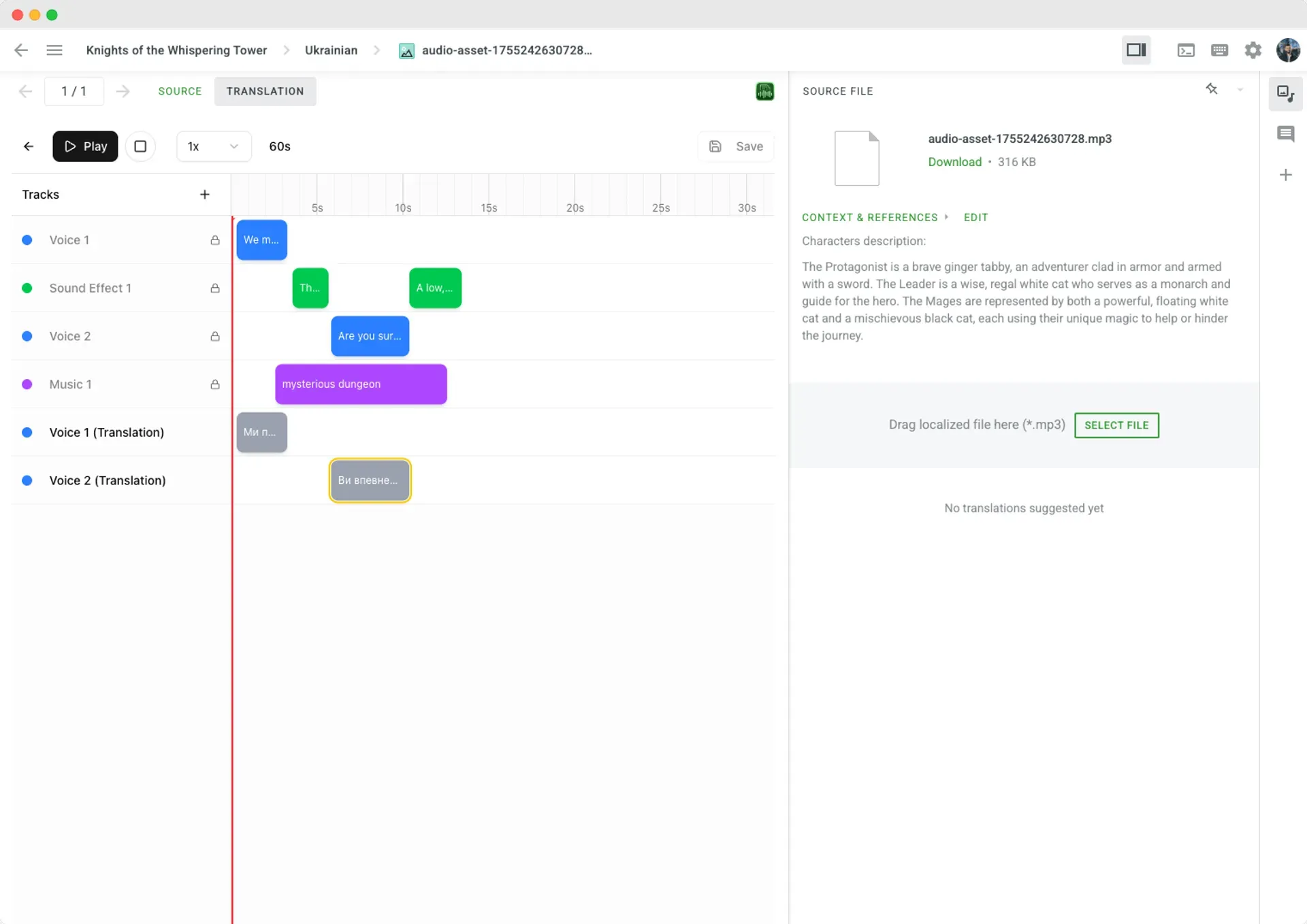
Crowdin Dubbing Studio simplifies professional dubbing, making it affordable for any team. The tool features a professional audio editor and uses AI with ElevenLabs integration. So with this app, you can generate voice, sound effects, and music in multiple languages. It uses translation memory, linking audio clips to source text, and integrating screenshots for context for better translation results.
Localize your course with Crowdin
Maintaining Consistency Across Multiple Languages
Imagine a training course for a new product where a key term is translated differently in five different language versions. That might be confusing. Keeping terminology consistent across all your multilingual courses can be a big challenge. Especially if you have a large team.
Solution: The best way to solve this is by using a TMS with translation memories and glossaries. A translation memory stores every phrase you translate. When that same phrase appears again, the system automatically suggests the previous translation.
A glossary acts as a dictionary for key terms. It ensures that “beta testing” is always translated the same way, no matter which professional translators are on the project.
Managing Translation Projects at Scale
Large-scale eLearning localization projects can quickly become overwhelming. You’re juggling hundreds of files, dozens of languages, and a team of translators, reviewers, and project managers. Without a solid system, this can lead to missed deadlines and version control disasters.
Solution: A centralized, cloud-based TMS is a lifesaver here. It automates much of the manual work, like assigning tasks and tracking progress. A project manager can see the status of every single file in every language from one dashboard. A platform for translation management makes it much easier to scale your eLearning solutions.
Quality Assurance for Diverse Audiences
A mistranslation, no matter how small, can ruin the credibility of your eLearning content. You need to make sure the final product is accurate, culturally appropriate, and reads naturally to a native speaker. Manual checks are slow and prone to human error, especially when dealing with high-volume multimedia content.
Solution: Use a platform with built-in quality assurance (QA) checks. These tools can flag spelling errors, grammar mistakes, and terms that don’t match your glossary.
Platforms like Crowdin let a local reviewer see the translated content exactly as it will appear in the course. This is called in-context review.
Mastering the Technical Workflow and File Formats
The last thing you want is a messy, manual process of exporting text from your eLearning tools and then re-importing it after localization. This is a huge time-waster and can lead to errors.
The real key to a smooth process isn’t about a single integration but about a platform that can handle the specific file formats your content lives in. eLearning courses, often built with standards like xAPI, consist of various files, including XML, HTML5, and JSON. A great translation management system can take a complex file, find all the text that needs translating, and put the finished translation back in the right place automatically.
This creates a workflow that connects your entire content ecosystem. For example:
- Design Tools. Your course’s text and visuals might start in a design program like Figma or Sketch. An integration here lets you pull that text for translation early in the process.
- Website and Marketing Content. The descriptions, landing pages, and marketing copy for your course should also be translated to match. A Website Translator integration ensures all of this content is consistent.
- Video Subtitles. If your course includes videos, a platform should handle subtitle translation. This ensures the translated text is synced with the on-screen action. You can see the wide range of tools for this on the Crowdin Store.
Essential Tools for eLearning Courses Localization
Handling eLearning localization projects without the right tools is like building a house with a hammer and a saw. It gets the job done, but it’s a slow and painful process. Modern technology automates the tough stuff, making the entire process faster and accurate.
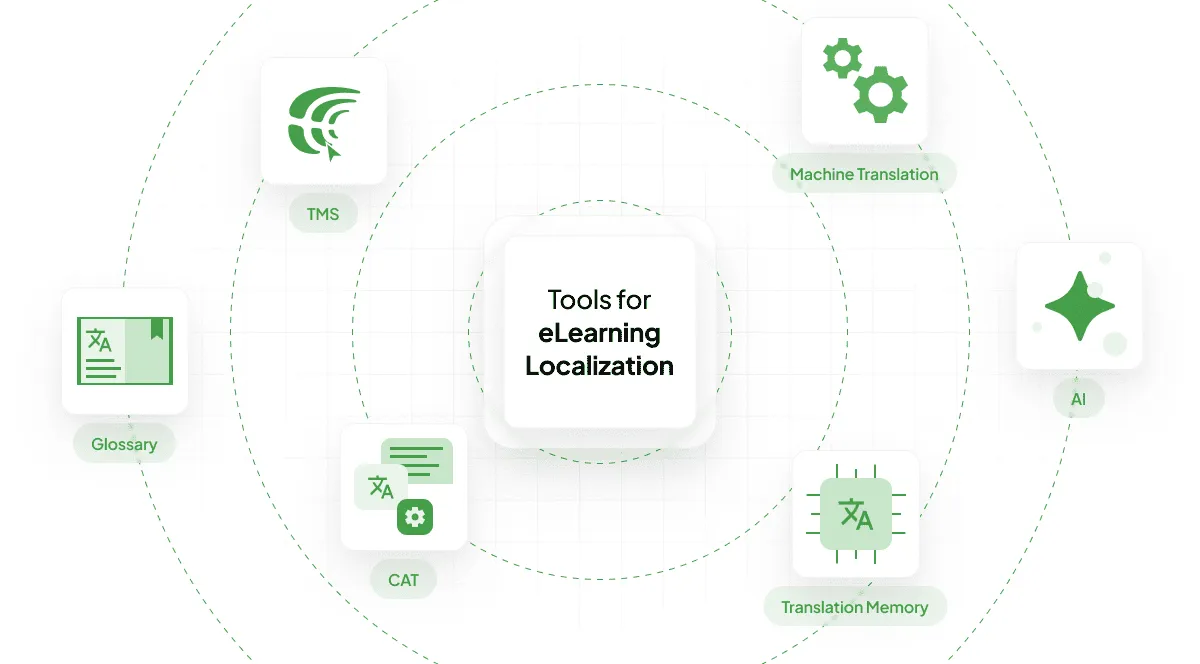
Translation Management System (TMS) Overview
TMS is the command center for your entire localization. A platform like Crowdin isn’t just for translating. It’s a hub where you manage projects, collaborate with teams, and keep all your content and resources organized.
A TMS gives you a bird’s-eye view, helping you:
- Centralize Everything. All your source files, translated content, and reference materials live in one secure place.
- Automate Workflows. It handles the boring tasks, like sending new files to translators and notifying reviewers, so you can focus on the big picture.
- Track Progress. You can see exactly what percentage of a project is complete for each target language, giving you total control.
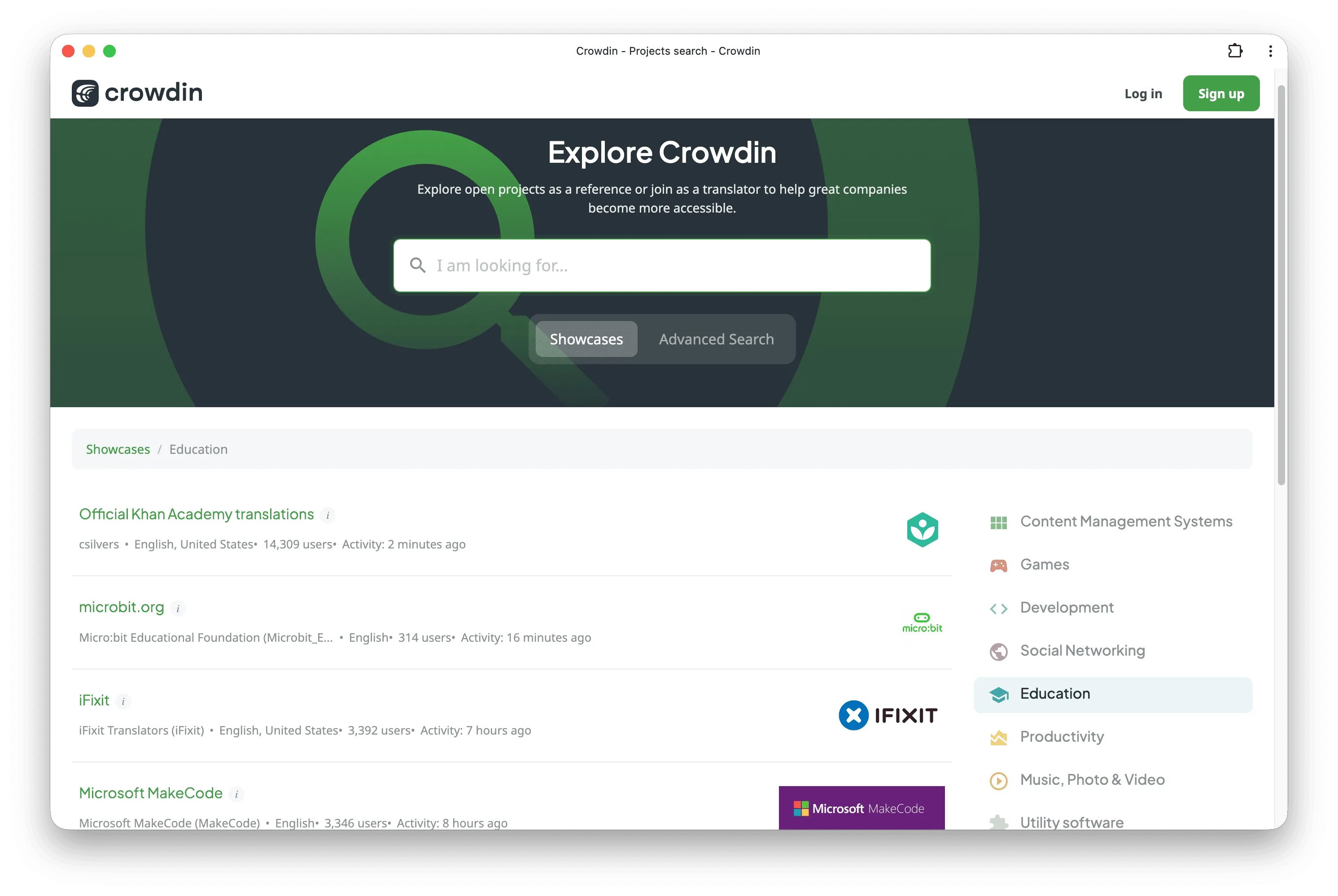
Here are some of the open educational projects on Crowdin. Explore them as a reference or join as a translator to help great companies become more accessible!
Computer-Assisted Translation (CAT) Tools
CAT tools are the powerful engines inside the TMS that help translators do their jobs faster and more consistently. This is not the same as machine translation.
A good CAT tool includes:
- Translation Memory. This is a database that remembers every sentence you’ve ever translated. If the same phrase appears again, the system suggests the previous, approved translation. It saves a huge amount of time and money, especially for eLearning materials with repeated phrases.
- Terminology Management. This is essentially a smart glossary for your key terms, product names, or industry jargon. It ensures that “beta testing” is always translated the same way, no matter who’s working on the project.
- In-Context Editing. This feature allows a professional translator to see the text they’re working on exactly as it will appear in the final course. They can see the surrounding images and layout, which helps them create a translation that fits perfectly and sounds natural.
AI in eLearning Localization
AI localization is now a standard part of the translation process. It helps companies get their content to market much faster, reducing the time-to-market.
Here’s what a modern localization platform can do with AI:
- AI can analyze your source content to automatically identify what needs to be translated. It can extract embedded text from images or videos, saving hours of manual work.
- AI-powered QA checks go beyond simple spelling and grammar. They can analyze the context, check for consistency with your glossaries and style guides, and even predict the quality of a machine translation before a human ever looks at it.
- Modern AI models (like Agentic AI) can access contextual information about your project (screenshots, file names, or even a previous version of a course) to provide much more accurate and relevant suggestions.
- A top-tier platform doesn’t just use one AI engine; it can use many. You can choose the best provider for a specific target language and content type. Crowdin, for example, supports over 10 AI providers, giving you full flexibility. For enhanced security, you can use your own API keys, which gives you complete ownership and control over your data.
Cultural Localization
To make your eLearning content effective, you need to localize it. This is the process of adapting your content to the learner’s cultural context. It’s about creating a connection, not just a conversion.
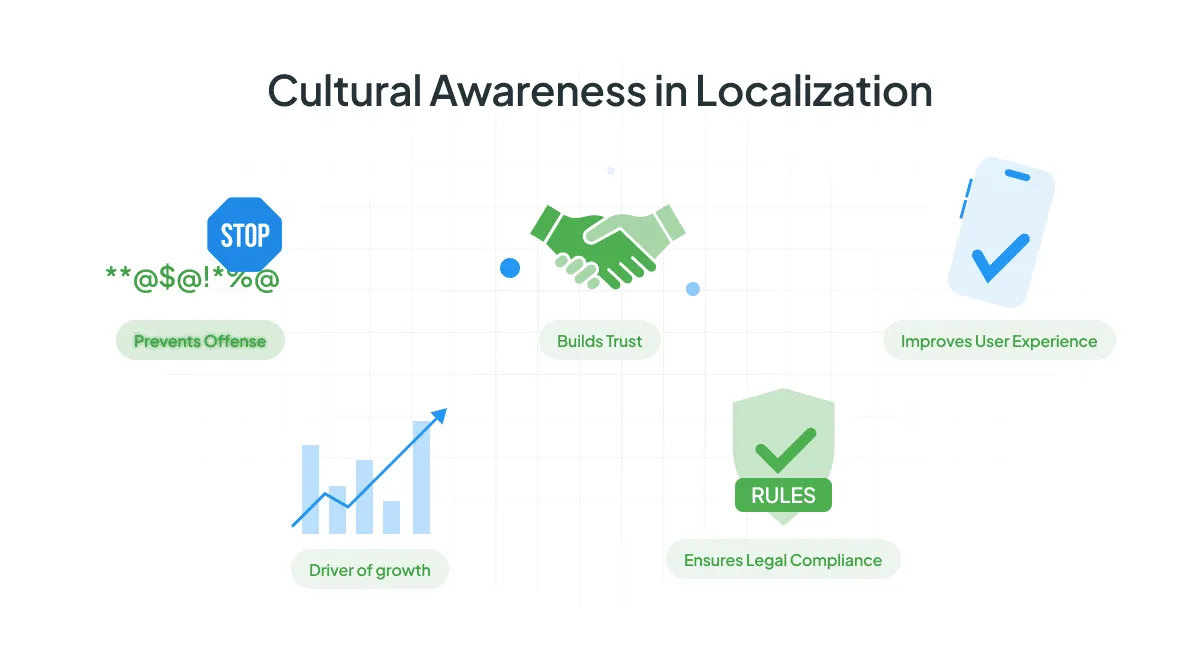
Visual Elements and Cultural References
Imagine you’re taking a course on teamwork that shows a thumbs-up emoji to celebrate a successful project. While that’s a positive symbol in many Western countries, it can be offensive in parts of the Middle East and Africa. That’s a tiny example of a big problem.
Localization ensures that all visual and cultural elements resonate with your learners. This means you should:
- Change Images and Graphics: Replace photos of people, settings, and clothing with images that reflect the local population and environment. For example, a business course for Japan might show people bowing, while a similar course for the US might show a handshake.
- Adjust Symbols and Colors: Be aware of what colors mean in different cultures. While red might symbolize luck and happiness in China, it can represent danger in many Western countries.
- Replace Idioms and Analogies: A reference to “hitting a home run” in a sales course won’t make sense to global learners who’ve never heard of baseball. It should be replaced with a culturally relevant analogy, like “scoring a goal” in soccer, which has a wider global reach.
Different Learning Styles Across Cultures
Learning isn’t universal. How people prefer to learn is often shaped by their cultural background and education system. Some cultures favor a more instructor-led approach, while others prefer interactive, group-based learning.
By understanding these differences, you can tailor your instructional design. This could mean:
- For cultures that value authority and hierarchy, a more formal, lecture-based style may be more effective.
- For cultures that are more collaborative, you might add more group exercises and discussion prompts.
- For cultures that are more “hands-on”, adding more interactive simulations and case studies can be beneficial.
Localizing Assessment Methods and Feedback Systems
Even your quizzes, tests, and forms need to be localized. The way you ask a question and the way you provide feedback can have a big impact.
- Assessment Content. Make sure your questions use culturally relevant examples and scenarios. A question about US tax law won’t be a good fit for a course in Europe.
- Feedback Tone. The tone of your feedback should be adjusted. Some prefer direct feedback to help them improve, while others respond better to more encouraging feedback.
- Response Formats. Ensure date formats, phone numbers, and currency symbols are all correct for the target language audience. For example, a date displayed as MM/DD/YYYY in the US should be DD/MM/YYYY in Europe.
Cultural Nuances in Instructional Design
The little things make a big difference. Instructional designers must be aware of subtle cultural nuances that can affect the learning experience. This includes:
- Respectful Communication. The tone of a course for a US audience might be very casual and friendly. A course for a Japanese audience, however, might need a more formal and respectful tone to be taken seriously.
- Role of the Learner. In some cultures, learners are expected to be passive recipients of knowledge. In others, learners are expected to actively challenge the instructor’s views and engage in debate. Your course design should reflect these expectations to maximize training effectiveness.
By putting this much thought into cultural localization, you’re doing more than just translating words. You’re building a bridge between your content and your learners.
Choosing the Right Localization Partners
Choosing the right partner is one of the most important decisions you’ll make for your eLearning translation projects. The ideal partner combines linguistic expertise with deep technical knowledge of eLearning solutions. This isn’t just about finding someone who speaks the language; it’s about finding a strategic ally.
Professional Translators vs. Translation Agencies
You have a few options when it comes to who does the work.
- Individual Translators. A freelance translator can be a good choice for small, straightforward projects. They might offer a lower cost but often lack the scalability and technical tools needed for large, ongoing eLearning translation efforts.
- Translation Agencies. These are full-service providers that offer a complete solution, including project management, access to a network of linguists, and quality control. They are better equipped to handle complex and high-volume multilingual courses.
- In-house Team. With a platform like Crowdin, your own in-house team can manage project translations. This gives you the control and tools of a powerful platform combined with the expertise of your own team.
Industry Expertise and Subject Matter Knowledge
For technical or specialized eLearning content, it’s important that your partner has subject matter expertise. A medical training course requires a translator with a background in healthcare. A software training module needs a linguist familiar with tech jargon.
Scalability and Project Management Capabilities
As your company grows, your partner should be able to grow with you. A platform-based solution lets you add new languages, manage more projects, and bring on new team members without a lot of hassle. The right partner will also have strong project management to ensure your projects are delivered on time.
Future Trends in eLearning Localization
The eLearning translation landscape is constantly evolving. AI, automation, and new technologies are changing how we localize content, making the process faster and more personalized than ever before. Here’s what’s on the horizon for eLearning translation needs.
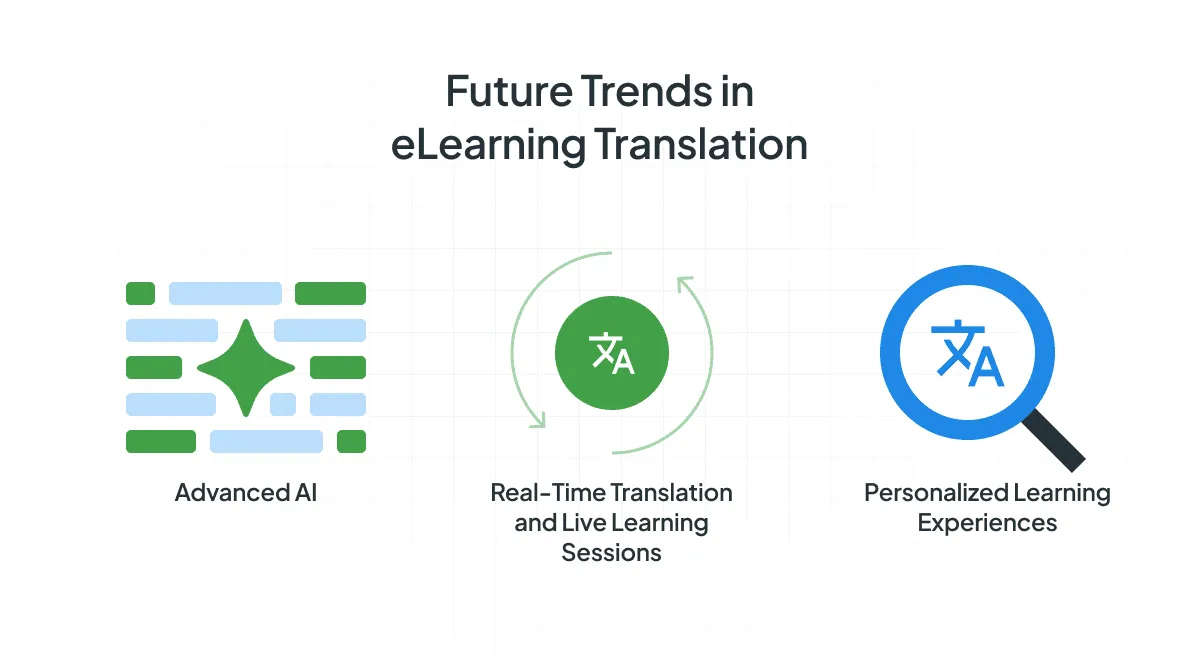
AI Capabilities Will Become More Advanced
AI has already made a huge impact on translation processes, but the technology is still in its early stages. In the future, AI will be able to handle even more complex tasks. It won’t just provide a draft translation; it will be able to analyze the cultural context, tone, and style of your eLearning content and make smart suggestions that are more accurate and nuanced. AI will become a truly collaborative partner, assisting human experts in creating perfect multilingual courses faster.
Curious about the tech that makes this possible? Read about the Best LLMs for Translation
Real-Time Translation and Live Learning Sessions
Live virtual classrooms and webinars are becoming the norm, and the demand for real-time translation is growing. Soon, AI-powered tools will offer live, on-the-fly captioning and voice translation for live learning sessions. This will allow people from different parts of the world to participate in the same training event, breaking down language barriers instantly and opening up truly global learning experiences.
Personalized Learning Experiences Across Languages
The next evolution of eLearning solutions will involve personalized learning paths that adapt to the individual learner. When combined with eLearning translation, this means courses will not only adapt to a learner’s pace and skill level but also to their native language and cultural background. Imagine a course that automatically adjusts its examples and case studies based on where the learner is located, all while staying in sync with the master version.
eLearning Localization Checklist
After learning about the benefits and best practices, you might be ready to take the first step. Here’s a simple guide to help you begin.
Assessing Your Translation Needs and Goals
Before you do anything, you need a clear plan. Ask yourself a few key questions:
- What are your goals? Are you trying to expand into a new market, train a global workforce, or simply increase accessibility?
- Who is your audience? Identify your target learners. What is their native language? What are their cultural norms?
- What content needs translating? You don’t have to translate everything at once. Start with your most critical eLearning content, like core training modules or key product tutorials.
Internal Capabilities vs. Outsourcing
You have a choice when it comes to who does the work.
- Outsourcing is great for companies with a high volume of content or a need for a wide range of languages. It’s a hands-off approach that can save time.
- Building internal capabilities is a great option if you have a dedicated in-house team. A platform like Crowdin can empower your team with the tools they need to manage the entire localization process directly.
- Most organizations use a hybrid approach, where a central team manages the project on a platform and works with a mix of internal linguists and external agencies or freelancers.
Localization Workflow and Timeline
A clear process is key to success. Here’s a simple workflow you can follow:
- Prepare your files: Make sure all your source content is finalized and clean.
- Upload to your platform: Import your content into a TMS like Crowdin.
- Translate and review: Your translators do the work, and a local reviewer checks it to ensure quality.
- Test the final product: Test the localized course with a small group of native speaker learners to catch any final issues.
- Launch and measure: Deploy the course and track key metrics like completion rates and learner feedback.
Measuring Success and Continuous Improvement
Once your translated eLearning content is live, your work isn’t done. Use learner feedback and performance data to see what’s working and what isn’t. By continuously refining your multilingual courses, you ensure they remain effective and valuable to your diverse audiences for years to come.
Conclusion
Go Global, Stay Local. The goal of eLearning localization isn’t just to translate; it’s to connect. By adapting your courses to different cultures and languages, you make your content relevant and effective for an international audience. This is how you grow your reach, improve learning outcomes, and build a global brand.
The Future Is Multilingual.
FAQ
How Long Does eLearning Translation Take?
The timeline varies a lot. It depends on the amount of content, the number of languages, and the complexity of the project. A modern TMS can greatly speed up the process compared to manual workflows.
How Do You Ensure Quality in Translated eLearning Content?
You need a multi-step process. First, use a professional translator who is also a subject matter expert in your field.
Second, always include an in-context review. This is a critical step where a local reviewer can check the translated text exactly as it will appear in the course.
Finally, use a translation management system with automated quality assurance checks. These tools can automatically flag errors, inconsistent terms, and formatting mistakes before a human even sees them.
Can Machine Translation Be Used for eLearning Content?
Yes, but it’s best to combine it with human review. Machine translation provides a quick first draft, but a human expert is needed to ensure the final version is accurate and sounds natural to the learner.
Yuliia Makarenko
Yuliia Makarenko is a marketing specialist with over a decade of experience, and she’s all about creating content that readers will love. She’s a pro at using her skills in SEO, research, and data analysis to write useful content. When she’s not diving into content creation, you can find her reading a good thriller, practicing some yoga, or simply enjoying playtime with her little one.
